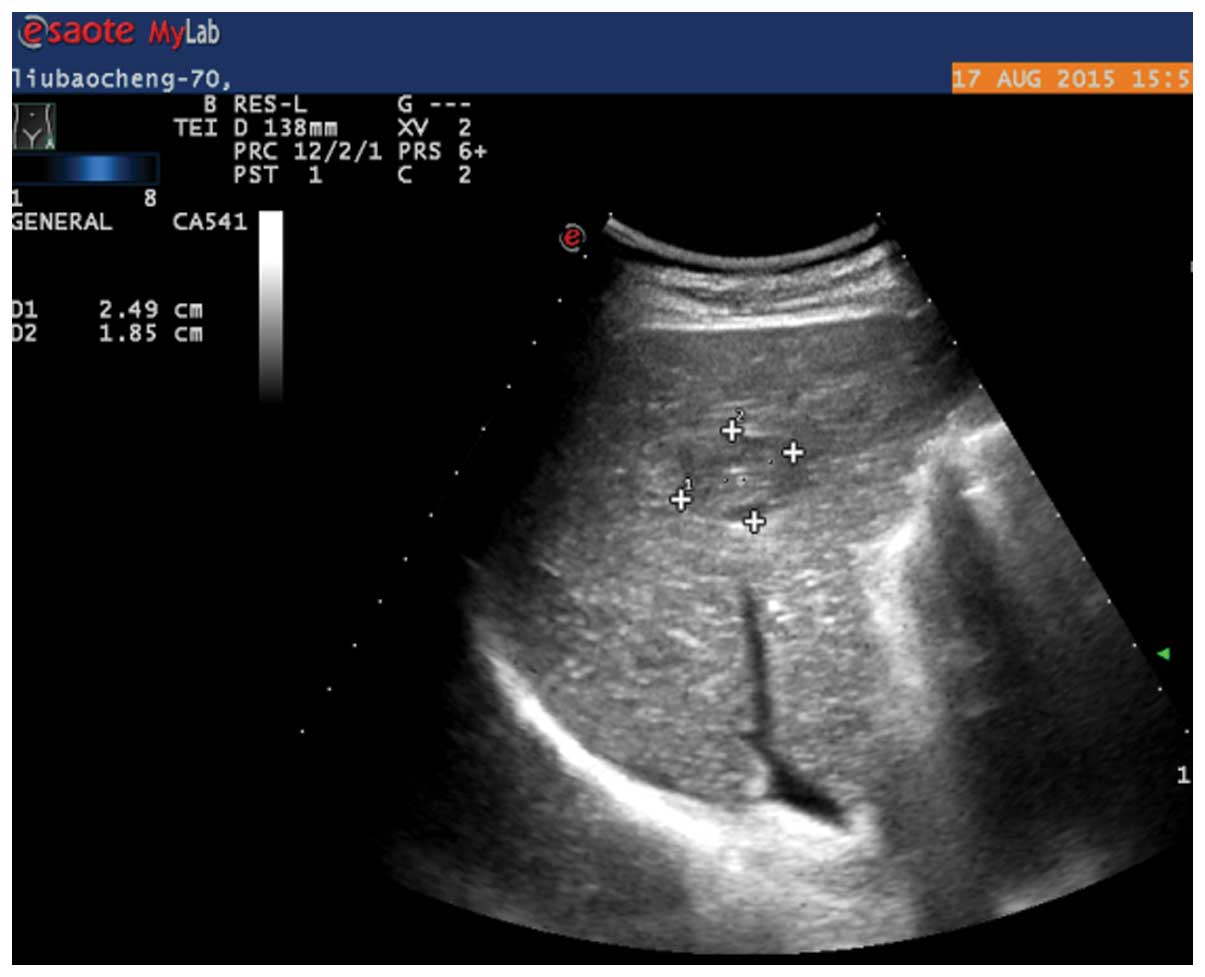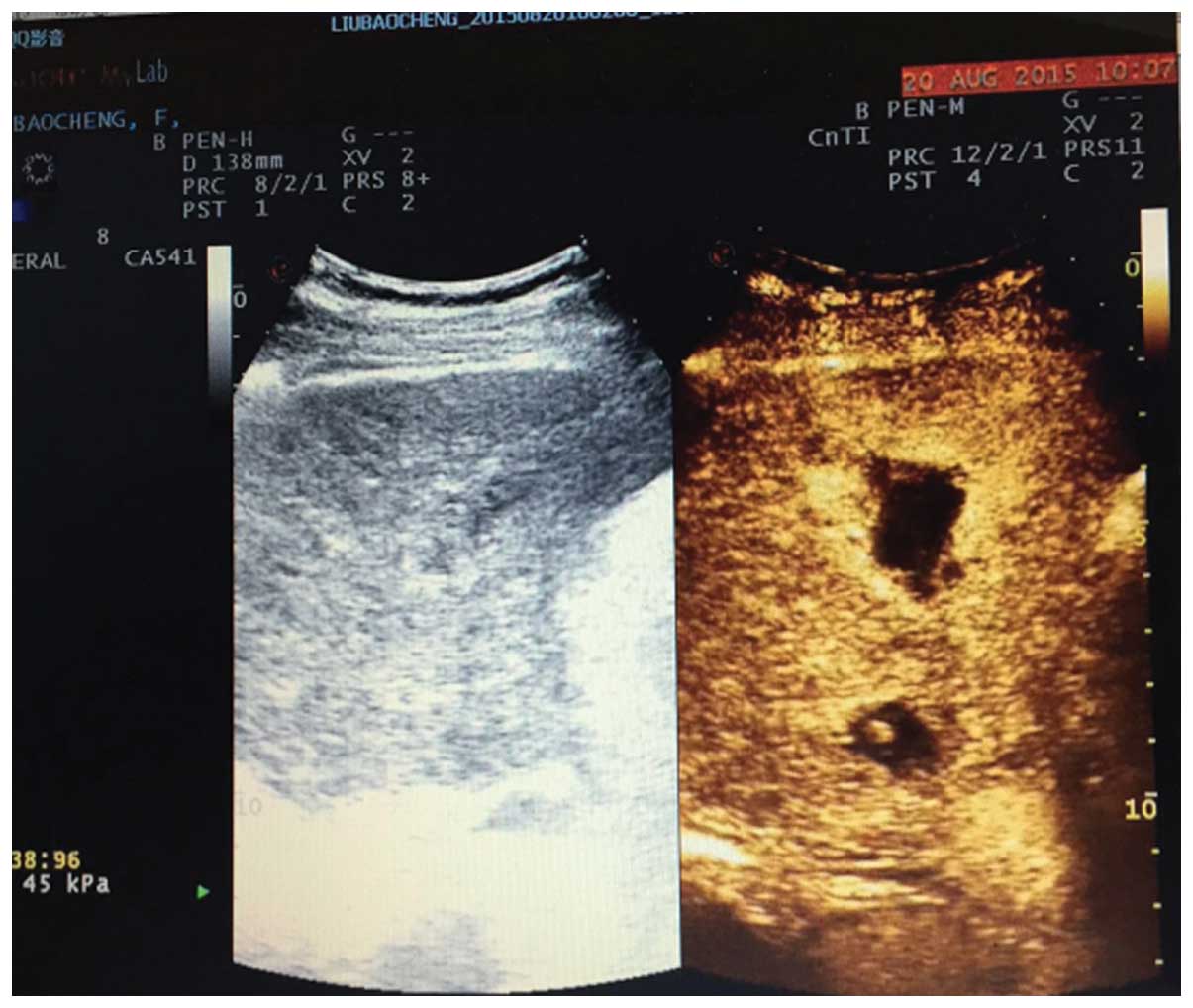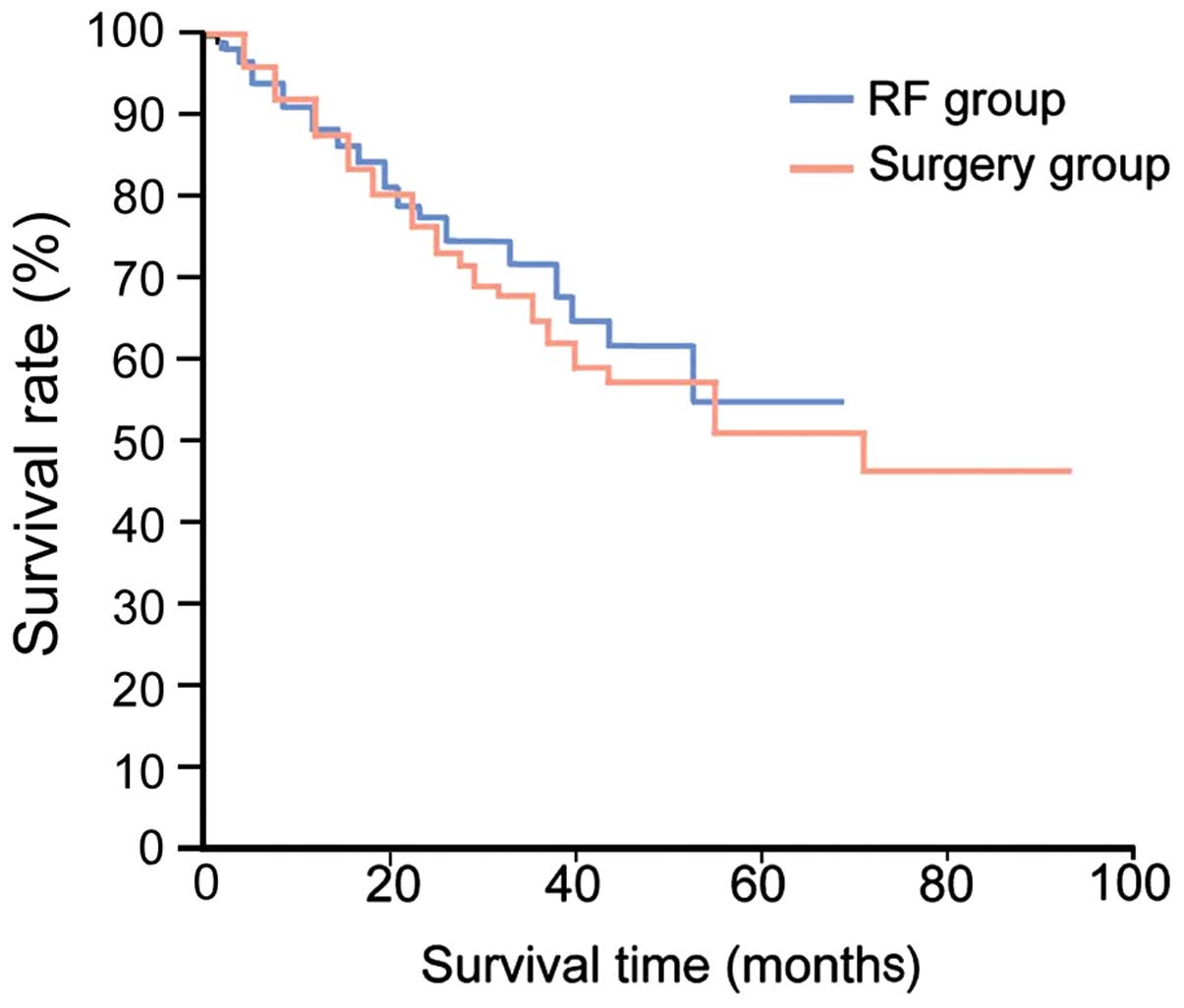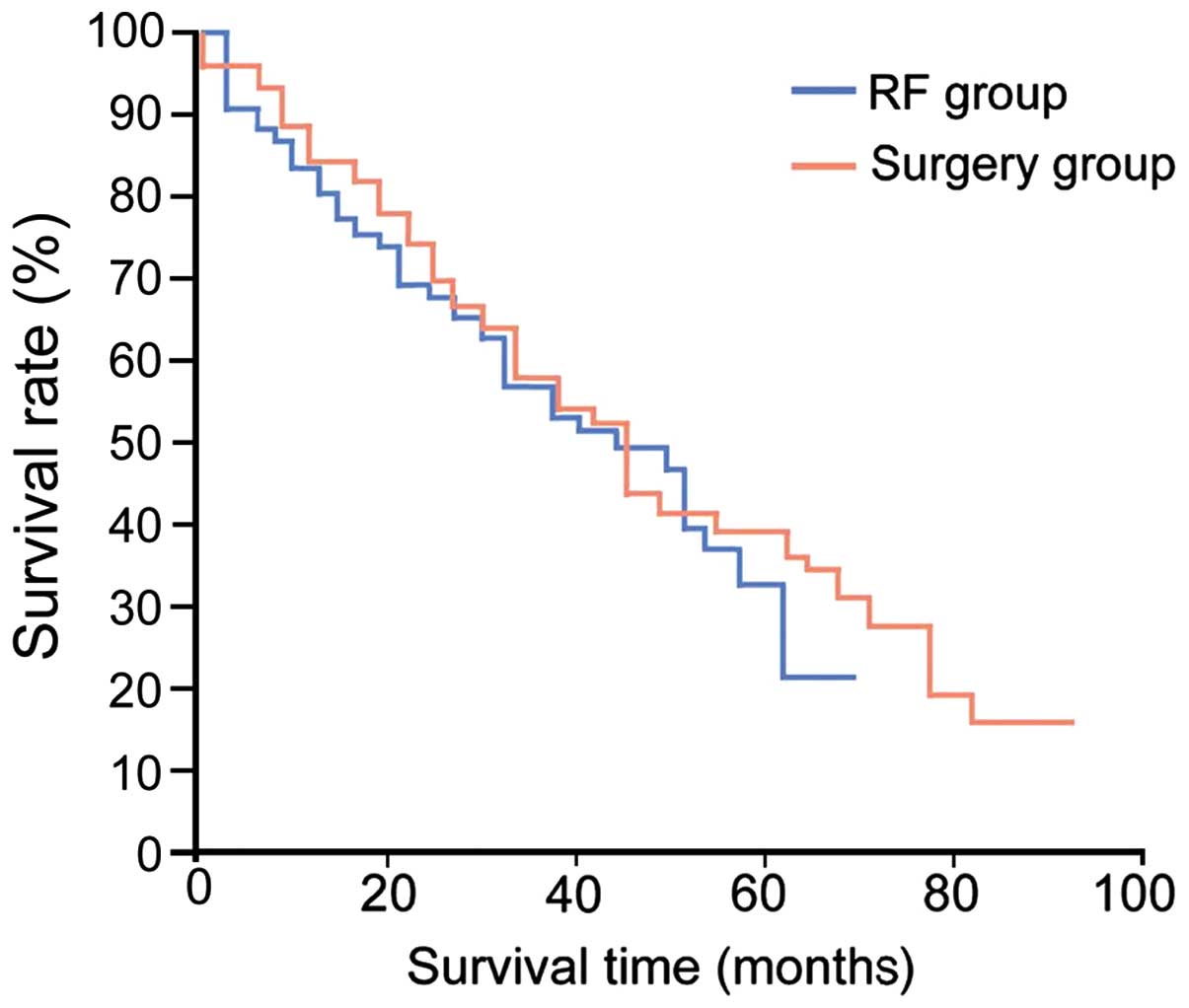Introduction
The number of cases with primary hepatocellular
carcinoma (HCC) has been on the increase in recent years
Theincidence has reached to 250,000 new cases per year (1,2). the
mortality was relatively high and the five-year survivalrate was as
low as 5% (1). Males were diagnosed
more oftenthan females (5:1). Males over 40 and females 0ver 60 are
the most affected population (2).
Small HCC refers to a cancer nodule with an isolated tumor diameter
of ≤3 cm clinically or a type of HCC with the sum of the diameters
of the tumors on two adjacent nodules at ≤3 cm (1).
Laparotomy is currently recognized as an important
method for the treatment of early small HCC, although such
treatment schemes lead to relatively large body trauma (3). Radiofrequency ablation (RFA), a
minimally invasive surgery employed in recent years, has caused
increasing concern and demand on the medical profession in the
clinical treatment of malignant tumors (4,5). Sorafenib
belongs to a multi-kinase inhibitor that blocks the generation of
new blood vessels in the body of cancer patients and effectively
inhibits cancer cell growth and proliferation. Previous findings
(6,7)
confirmed that sorafenib improved the prognosis of advanced HCC,
but, to the best of our knowledge, the clinical effect in the
treatment of the early small HCC has rarely been reported.
The aim of the present study was to investigate the
clinical effect of combined sorafenib and RFA in the treatment of
early small HCC, compared with the clinical effect of laparotomy
resection and subsequently contrast the difference between the two
treatment methods to assess their usefulness in the clinic.
Patients and methods
General information
In total, 120 patients (134 lesions) with early
small HCC admitted to the Xinhua Hospital (Shanghai, China) between
May 2007 and June 2010 were selected and included in the study. The
enrolled cases were patients initially admitted and treated in the
hospital, including 68 men and 52 women, aged 45–71 years, with a
mean age of 62.6±2.5 years. Concerning clinical stages, there were
64 and 56 cases at Ia and Ib stages, respectively, and all the
cases were consistent with the clinical diagnostic criteria for
primary HCC and confirmed by pathology. Simultaneously the color
Doppler ultrasound examination identified a tumor size ≤3 cm.
Inclusion criteria for the study were: i) Patients
aged 45–71 years, primarily diagnosed as early small HCC, ii)
patients in exhibiting tumors as per the 2001 Hepatocellular
Carcinoma Clinical Diagnostic Criteria and Clinical Stage, iii)
patients with a tumor diameter of ≤3 cm, iv) patients without
angiogenesis, bile duct violation, or distant metastasis; v)
patients with liver function grading: Child-Pugh A or B, and vi)
patients who signed the written informed consent form and agreed to
undergo the treatment employed in the study. Patients with a liver
function of Child-Pugh C grade, serious function failure of other
vital organs and communication disorders and those not willing to
participate in the study were excluded.
The 120 enrolled patients with small HCC (134
lesions) were divided into the surgery (n=60) and RF (n=60) groups
in accordance with the treatment method. There were 60 cases
including 67 lesions in the surgery and RF groups,
respectively.
Approval for the study was obtained by the ethics
committee of Xinhua Hospital.
Methods
The surgery group received laparotomy resection
treatment under general anesthesia.
Combined sorafenib and RFA were used to treat the RF
group. The percutaneous microwave ablation method was conducted as
follows. Briefly, the microwave therapy apparatus was purchased
from the Baoxing Medical Equipment Co., Ltd. (Jiangsu, China). The
microwave operating frequency was set at 915 MHz, the output
operation power was set at 30–50 W, and the transmission mode was
set to pulse. Prior to accepting microwave ablation by irradiation,
the patients underwent blood routine examination, liver function,
prothrombin time, and other indicators. The patients were fasted on
the date treatment was administered, while simultaneously, the
intravenous accesses were established prior to treatment. The
patients were generally treated under intravenous anesthesia.
Following localization of the lesion using an ultrasonic instrument
(Dynaflox Shanghai Tech Co., Ltd., Shanghai, China), the electrode
was sent to the lesion site to be punctured under the guidance of
contrast-enhanced ultrasonography (CEUS), and 5 mm was routinely
cut around the tumor for the placement of the temperature measuring
needle. Microwave power, treatment time, and other combinations
were set according to the size of the lesion tissue, and the
microwave ablation stop indication occurred when the temperature
around the tumor was at 60°C and reached 54°C for a duration of 3
min. The case treatment time of each group was ~5–10 min. The
entire operation was performed under ultrasound dynamic and
continuous monitoring. The electrocardiograph monitoring and oxygen
situation of the patients were observed during the treatment and
changes in the heart rate and blood pressure of the patients were
strictly monitored. Of the 60 patients in the surgery group, 48
cases underwent ablation once, 10 cases underwent ablation twice,
and 2 cases underwent ablation three times.
The sorafenib treatment method was carried out by
treating patients in the RF group with additional sorafenib based
on the abovementioned percutaneous microwave ablation method, i.e.,
0.4 g of sorafenib was administered [Bayer Schering Pharma AG
(Berlin, Germany), approval no. H20130137] each time: twice daily,
orally 2 h after a meal, for 4 weeks.
Efficacy evaluation
After 1 month of treatment, all the cases underwent
enhanced CT, α-fetoprotein (AFP), and other examinations to
evaluate the clinical efficacy, and a detailed record was made on
each follow-up situation. If a patient was found with a new lesion
versus the primary lesion or elevated AFP during the follow-up, it
was considered as a tumor recurrence following treatment (8).
Statistical analysis
Data were statistically analyzed using SPSS 20.0
software (SPSS, Inc., Chicago, IL, USA). Comparison between groups
was made with the t-test or Chi-square test. The overall survival
and tumor-free survival rates were calculated using the
Kaplan-Meier calculation method and analyzed with the log-rank
test. A multifactor prognosis analysis was performed using the Cox
proportional hazard model to obtain the independent risk factors
affecting prognosis. P<0.05 was considered to indicate a
statistically significant difference.
Results
Comparison of the short-term efficacy
and follow-up recurrence of the patients between the groups
After 1 month of treatment, the radical effective
rate of the surgery and RF groups was 100%. The contrast-enhanced
ultrasound image of the patient in the RF group prior to and after
treatment is shown in Figs. 1 and
2. During the 5-year follow up, the
tumor recurrence rate of the surgery group was 18.3%, significantly
lower than the tumor recurrence rate in the RF group which was
38.3% (P<0.05) (Table I).
 | Table I.Comparison of tumor follow-up
recurrence between the two groups. |
Table I.
Comparison of tumor follow-up
recurrence between the two groups.
| Group category | No. | Local recurrence | Distant
recurrence | Distant
recurrence | Recurrence rate,
% |
|---|
| Surgery | 60 | 2 | 9 | 0 | 18.3 |
| RF | 60 | 7 | 12 | 4 | 38.3 |
Comparison of complications between
the groups
The occurrence rates of the postoperative pain,
fever, abdominal bleeding, infection, and other complications of
patients in the surgery group were significantly higher than the
complication incidence rate (P<0.05) of the patients in the RF
group (Table II).
 | Table II.Comparison of adverse reactions
between the two groups. |
Table II.
Comparison of adverse reactions
between the two groups.
| Group category | No. | Pain (%) | Fever (%) | Abdominal bleeding
(%) | Infection (%) |
|---|
| Surgery | 60 | 38 (63.3) | 29
(48.3) | 7
(11.7) | 18 (30) |
| RF | 60 | 14 (23.3) | 15 (25) | 2 (3.3) | 1
(1.7) |
Comparison of the survival rates
between the groups
The average survival time of the patients in the
surgery group was 51.2±1.5 months, and the survival rates during
the first, third and fifth year were 90.7, 71.5 and 56.7%,
respectively. The average survival time of the patients in the RF
group was 64.6±2.4 months, and the survival rates during the first,
third and fifth year were 91.1, 72.8 and 57.5%, respectively. The
difference between the two groups was not statistically significant
(Fig. 3).
The tumor-free survival rates in the surgery group
during the first, third and fifth year were 87.8, 44.3 and 33.2%,
respectively. The tumor-free survival rates in the RF group during
the first, third and fifth year were 86.2, 48.3 and 34.6%,
respectively. The difference between the two groups was not
statistically significant (Fig.
4).
Discussion
RFA treatment has attracted much attention from the
medical community in the treatment of neoplastic diseases.
Treatments including minimal invasive surgery and simple operation
are currently considered viable HCC intervention treatment methods
with improved prospects (9,10). Previous studies have reported that
(9–11), on the one hand, RFA can achieve
necrosis of cancer cells by directly coagulating them and killing
cancer tissues. On the other hand, RFA can increase the number of
local immune cells in the tumor and tumor cells in peripheral blood
of the tumor, thereby reducing the metastasis of cancer cells.
Implementation of ablation treatment against HCC should be achieved
based on imaging methods, which primarily include ultrasound,
magnetic resonance, and computed tomography (12–15). In
terms of the implementation of RFA under ultrasonic labeling in the
treatment of patients with HCC disease, previous findings have
confirmed that this method has many advantages such as no radiation
on the human body, simple operation, and the ability to observe
lesions in real time. However, in contrast to an ultrasonic image
cannot be formed due to small liver lesions, no vessel violations
and iso-echoic HCC, ordinary ultrasound labeling is inadequate as
it is difficult to accurately locate the cancer tissue (16–18).
Consequently, during the treatment of HCC by RFA, CEUS technology
should be employed as it enhances image sharpness and contrast,
detects enhanced blood flow data and the lesion infiltration range,
which cannot be identified by ordinary ultrasound, thereby
indicating the efficacy for more thorough treatment by RFA.
Previously, it was reported that CEUS technology increased the
clinical diagnostic rate of small HCC from 53 to 94% (19–21).
Targeted treatment of cancer is an emerging type of
technology together with the development of molecular and genetic
engineering. The application of such technology can improve the
survival rate of cancer patients by 5 years, and the disease
progression of the cancer patients, and significantly improve the
quality of life of the patients, thereby improving the survival
time of patients with tumor under palliative treatment. Due to the
above advantages, it has become a focus and hot spot in recent
years in cancer clinical treatment (22,23). The
multi-kinase inhibitor sorafenib (Nexavar) is an oral drug and a
multi-target signal transduction inhibitor, which can block the
growth and proliferation of a variety of tumor cells, inhibit the
growth of tumor microvessels and induce tumor cell apoptosis
simultaneously, with improved antitumor activity (24,25).
Sorafenib is the first molecular-targeted drug currently achieving
a good treatment effect in the clinical treatment of HCC (26). Combined sorafenib and RFA in the
treatment of early small HCC can play their respective efficacy of
RFA and sorafenib. The sorafenib mechanism for the treatment of
early small HCC may on the one hand, be that the cancer tissue
growth can be inhibited by inhibiting the signal transduction
pathway. On the other hand, the antitumor role can be exerted by
inhibiting the biological activity of several varieties of
tyrosinase receptors closely related to the growth of the new
micro-vessel and tumor development (24–26).
Regarding the scheme of the combined sorafenib and
RFA method and laparotomy resection in the treatment of early small
HCC in the present study, the implementation of laparotomy
resection was successful in treating the cancer lesions (100%),
although the bleeding volume during the laparotomy process was
relatively larger, and the presence of hepatic portal obstruction
led to relatively large trauma and other defects to the patients.
Simultaneously, the combined sorafenib and RFA treatment method has
many advantages, such as simple operation, minimally invasive
operation and small invasion, but also the defects of the residual
lesions after ablation. To this end, the comparison of the combined
sorafenib and RFA method and laparotomy resection method in the
treatment of early small HCC should be assessed mainly based on the
postoperative long-term prognosis. Hong et al (27) identified that the local recurrence
rate of RFA in the treatment of small HCC was relatively higher,
albeit there were no differences between the RFA method and
laparotomy resection method in the distant lesion metastasis and
overall survival rates. Ikeda et al (28) believed based on their studies that, in
the course of the treatment of small HCC, by cost-benefit
comparison, RFA had a better treatment effect compared to
laparotomy resection, and that oral sorafenib as supplemental
treatment after RFA treatment can significantly reduce the
recurrence rate of small HCC.
The present findings have shown that after one month
of treatment, the radical effective rate in the surgery group and
RF group was 100%. Contrast-enhanced ultrasound images were used to
obtain the result for patients in the RF group. During the 5-year
follow-up, the tumor recurrence rate in the surgery group was
18.3%, significantly lower than the tumor recurrence rate in the RF
group at 38.3% (P<0.05). The occurrence rates of postoperative
pain, fever, abdominal bleeding, infection and other complications
in the surgery group were significantly higher than the
complication occurrence rate (P<0.05) of patients in the RF
group. The average survival time of the patients in the surgery
group was 51.2±1.5 months, the survival rates during the first,
third and fifth year were 90.7, 71.5 and 56.7%, respectively. The
average survival time of the patients in the RF group was 64.6±2.4
months, and the survival rates during the first, third and fifth
year were 91.1, 72.8 and 57.5%, respectively. The difference
between the two groups was not statistically significant. The
tumor-free survival rates in the surgery group during the first,
third and fifth year were 87.8, 44.3 and 33.2%, respectively. The
tumor-free survival rates in the RF group during the first, third
and fifth year were 86.2, 48.3 and 34.6%, respectively. The
difference between the two groups was not statistically significant
(P<0.05). Some studies (29,30)
suggested that, in terms of the overall survival rate and
disease-free survival rate, the clinical effect of combined
sorafenib and RFA was equivalent to that of the laparotomy
resection in the treatment, simultaneously the former's recurrence
rate was higher, albeit the latter had more complications. The
conclusions of the present study are more consistent with the
perspectives of Hong et al (27) and Ikeda et al (28) as described above.
In summary, the combined sorafenib and RFA method
and laparotomy resection method have their advantages in the
treatment of early small HCC, under the permissible hospital
medical conditions, with the former method being capable of
partially replacing the latter method and being used as a preferred
treatment means in the treatment of early small HCC.
Acknowledgements
The present study was supported by the National
Natural Science Foundation of China (nos. 81071888 and 81070344;
81000173, 81070322 and 81270491); the National Key Basic Research
project, no. 2012CB517501; the 100-Talents Program of the Shanghai
Municipal Health Bureau, (no. XBR2011007); the Cross Research Fund
of Shanghai Jiaotong University Biomedical Engineering (no.
YG2012MS37); the Shanghai Natural Science Foundation (no.
13ZR1426700); and Xinhua Hospital Clinical Research project (no.
15LC16).
References
|
1
|
Dy GK, Hillman SL, Rowland KM Jr, Molina
JR, Steen PD, Wender DB, Nair S, Mandrekar S, Schild SE and Adjei
AA: North Central Cancer Treatment Group Study N0326: A front-line
window of opportunity phase 2 study of sorafenib in patients with
advanced nonsmall cell lung cancer: North Central Cancer Treatment
Group Study N0326. Cancer. 116:5686–5693. 2010. View Article : Google Scholar : PubMed/NCBI
|
|
2
|
Cabibbo G and Craxi A: Epidemiology, risk
factors and surveillance of hepatocellular carcinoma. Eur Rev Med
Pharmacol Sci. 14:352–355. 2010.PubMed/NCBI
|
|
3
|
Peng L, Zhou Y, Ye X and Zhao Q:
Treatment-related fatigue with everolimus and temsirolimus in
patients with cancer - a meta-analysis of clinical trials. Tumour
Biol. 36:643–654. 2015. View Article : Google Scholar : PubMed/NCBI
|
|
4
|
Cheng AL, Kang YK, Chen Z, Tsao CJ, Qin S,
Kim JS, Luo R, Feng J, Ye S, Yang TS, et al: Efficacy and safety of
sorafenib in patients in the Asia-Pacific region with advanced
hepatocellular carcinoma: A phase III randomised, double-blind,
placebo-controlled trial. Lancet Oncol. 10:25–34. 2009. View Article : Google Scholar : PubMed/NCBI
|
|
5
|
Cucchetti A, Piscaglia F, Cescon M, Serra
C, Colecchia A, Maroni L, Venerandi L, Ercolani G and Pinna AD: An
explorative data-analysis to support the choice between hepatic
resection and radiofrequency ablation in the treatment of
hepatocellular carcinoma. Dig Liver Dis. 46:257–263. 2014.
View Article : Google Scholar : PubMed/NCBI
|
|
6
|
Zhai B and Sun XY: Mechanisms of
resistance to sorafenib and the corresponding strategies in
hepatocellular carcinoma. World J Hepatol. 5:345–352. 2013.
View Article : Google Scholar : PubMed/NCBI
|
|
7
|
Zhao X, Tian C, Puszyk WM, Ogunwobi OO,
Cao M, Wang T, Cabrera R, Nelson DR and Liu C: OPA1 downregulation
is involved in sorafenib-induced apoptosis in hepatocellular
carcinoma. Lab Invest. 93:8–19. 2013. View Article : Google Scholar : PubMed/NCBI
|
|
8
|
European Association For The Study Of The
Liver; European Organisation For Research and Treatment of Cancer:
EASL-EORTC clinical practice guidelines: Management of
hepatocellular carcinoma. J Hepatol. 56:908–943. 2012. View Article : Google Scholar : PubMed/NCBI
|
|
9
|
Gravante G, Overton J, Sorge R, Bhardwaj
N, Metcalfe MS, Lloyd DM and Dennison AR: Radiofrequency ablation
versus resection for liver tumours: An evidence-based approach to
retrospective comparative studies. J Gastrointest Surg. 15:378–387.
2011. View Article : Google Scholar : PubMed/NCBI
|
|
10
|
Bruix J and Sherman M: American
Association for the Study of Liver Diseases: Management of
hepatocellular carcinoma: An update. Hepatology. 53:1020–1022.
2011. View Article : Google Scholar : PubMed/NCBI
|
|
11
|
Bhardwaj N, Strickland AD, Ahmad F,
El-Abassy M, Morgan B, Robertson GS and Lloyd DM: Microwave
ablation for unresectable hepatic tumours: Clinical results using a
novel microwave probe and generator. Eur J Surg Oncol. 36:264–268.
2010. View Article : Google Scholar : PubMed/NCBI
|
|
12
|
Sherman M, Burak K, Maroun J, Metrakos P,
Knox JJ, Myers RP, Guindi M, Porter G, Kachura JR, Rasuli P, et al:
Multidisciplinary Canadian consensus recommendations for the
management and treatment of hepatocellular carcinoma. Curr Oncol.
18:228–240. 2011. View Article : Google Scholar : PubMed/NCBI
|
|
13
|
Yim HJ, Suh SJ and Um SH: Current
management of hepatocellular carcinoma: An Eastern perspective.
World J Gastroenterol. 21:3826–3842. 2015. View Article : Google Scholar : PubMed/NCBI
|
|
14
|
Ma H, Zhang Y, Wang Q, Li Y, He J, Wang H,
Sun J, Pan K, Chen M and Xia J: Therapeutic safety and effects of
adjuvant autologous RetroNectin activated killer cell immunotherapy
for patients with primary hepatocellular carcinoma after
radiofrequency ablation. Cancer Biol Ther. 9:903–907. 2010.
View Article : Google Scholar : PubMed/NCBI
|
|
15
|
Karabulut K, Aucejo F, Akyildiz HY,
Siperstein A and Berber E: Resection and radiofrequency ablation in
the treatment of hepatocellular carcinoma: A single-center
experience. Surg Endosc. 26:990–997. 2012. View Article : Google Scholar : PubMed/NCBI
|
|
16
|
Birsen O, Aliyev S, Aksoy E, Taskin HE,
Akyuz M, Karabulut K, Siperstein A and Berber E: A critical
analysis of postoperative morbidity and mortality after
laparoscopic radiofrequency ablation of liver tumors. Ann Surg
Oncol. 21:1834–1840. 2014. View Article : Google Scholar : PubMed/NCBI
|
|
17
|
Muallem N and Solomon SB: Advances in
interventional oncology: Percutaneous therapies. Curr Radiol Rep.
2:522014. View Article : Google Scholar
|
|
18
|
Morimoto N, Isoda N, Watanabe S, Otake T,
Hirosawa T, Tsukui M, Miyata N, Murayama K, Iwashita C, Takaoka Y,
et al: A case of small hepatocellular carcinoma treated with
laparoscopic multipolar radiofrequency ablation with a no-touch
ablation procedure. Clin J Gastroenterol. 7:510–515. 2014.
View Article : Google Scholar : PubMed/NCBI
|
|
19
|
Tsuji K, Yamazaki H, Nagai K, Matsui T,
Tomonari A, Kang J, Sakurai Y, Kodama Y and Maguchi H: A case of
laparoscopic radiofrequency ablation therapy using bipolar RFA
system for hepatocellular carcinoma. Kanzo. 54:819–825. 2013.
View Article : Google Scholar
|
|
20
|
Kawamura Y, Ikeda K, Fukushima T, Hara T,
Hosaka T, Kobayashi M, Saitoh S, Sezaki H, Akuta N, Suzuki F, et
al: Potential of a no-touch pincer ablation procedure for small
hepatocellular carcinoma that uses a multipolar radiofrequency
ablation system: An experimental animal study. Hepatol Res.
44:1234–1240. 2014. View Article : Google Scholar : PubMed/NCBI
|
|
21
|
Forner A, Reig ME, de Lope CR and Bruix J:
Current strategy for staging and treatment: The BCLC update and
future prospects. Semin Liver Dis. 30:61–74. 2010. View Article : Google Scholar : PubMed/NCBI
|
|
22
|
Soerjomataram I, Lortet-Tieulent J, Parkin
DM, Ferlay J, Mathers C, Forman D and Bray F: Global burden of
cancer in 2008: A systematic analysis of disability-adjusted
life-years in 12 world regions. Lancet. 380:1840–1850. 2012.
View Article : Google Scholar : PubMed/NCBI
|
|
23
|
Li L, Zhang J, Liu X, Li X, Jiao B and
Kang T: Clinical outcomes of radiofrequency ablation and surgical
resection for small hepatocellular carcinoma: A meta-analysis. J
Gastroenterol Hepatol. 27:51–58. 2012. View Article : Google Scholar : PubMed/NCBI
|
|
24
|
Kharaziha P, De Raeve H, Fristedt C, Li Q,
Gruber A, Johnsson P, Kokaraki G, Panzar M, Laane E, Osterborg A,
Zhivotovsky B, Jernberg-Wiklund H, Grander D, Celsing F, Bjorkholm
M, Vanderkerken K and Panaretakis T: Sorafenib has potent antitumor
activity against multiple myeloma in vitro, ex vivo, and in vivo in
the 5T33MM mouse model. Cancer Res. 72:5348–5362. 2012. View Article : Google Scholar : PubMed/NCBI
|
|
25
|
Tamaskar I, Garcia JA, Elson P, Wood L,
Mekhail T, Dreicer R, Rini BI and Bukowski RM: Antitumor effects of
sunitinib or sorafenib in patients with metastatic renal cell
carcinoma who received prior antiangiogenic therapy. J Urol.
179:81–86. 2008. View Article : Google Scholar : PubMed/NCBI
|
|
26
|
Waghray A, Balci B, El-Gazzaz G, Kim R,
Pelley R, Narayanan MK, Estfan B, Romero-Marrero C and Aucejo F:
Safety and efficacy of sorafenib for the treatment of recurrent
hepatocellular carcinoma after liver transplantation. CLIN
TRANSPLANT. 2013.27:555–561. View Article : Google Scholar : PubMed/NCBI
|
|
27
|
Hong SN, Lee SY, Choi MS, Lee JH, Koh KC,
Paik SW, Yoo BC, Rhee JC, Choi D, Lim HK, et al: Comparing the
outcomes of radiofrequency ablation and surgery in patients with a
single small hepatocellular carcinoma and well-preserved hepatic
function. J Clin Gastroenterol. 39:247–252. 2005. View Article : Google Scholar : PubMed/NCBI
|
|
28
|
Ikeda K, Kobayashi M, Saitoh S, Someya T,
Hosaka T, Sezaki H, Suzuki Y, Suzuki F, Akuta N and Arase Y:
Cost-effectiveness of radiofrequency ablation and surgical therapy
for small hepatocellular carcinoma of 3cm or less in diameter.
Hepatol Res. 33:241–249. 2005. View Article : Google Scholar : PubMed/NCBI
|
|
29
|
Feng X, Xu R, Du X, Dou K, Qin X, Xu J,
Jia W, Wang Z, Zhao H, Yang S, Guo C, Liu T and Ma K: Combination
therapy with sorafenib and radiofrequency ablation for BCLC Stage
0-B1 hepatocellular carcinoma: A multicenter retrospective cohort
study. Am J Gastroenterol. 109:1891–1899. 2014. View Article : Google Scholar : PubMed/NCBI
|
|
30
|
Berretta M, Di Francia R and Tirelli U:
Sorafenib combined with percutaneous radiofrequency ablation for
the treatment of medium-sized hepatocellular carcinoma. Eur Rev Med
Pharmacol Sci. 19:2521–2522. 2015.PubMed/NCBI
|


















